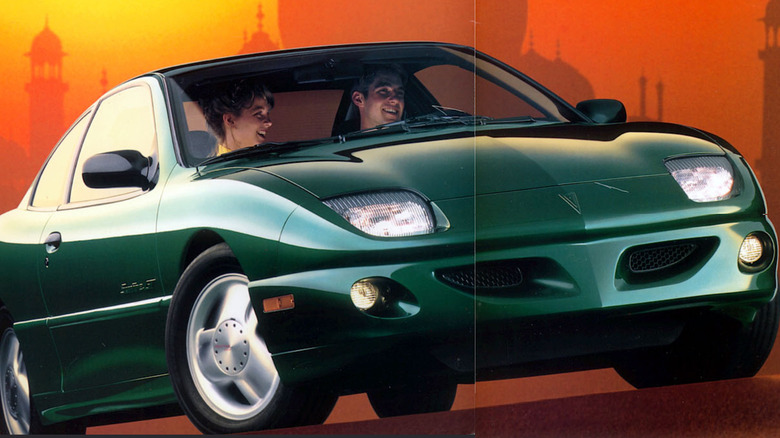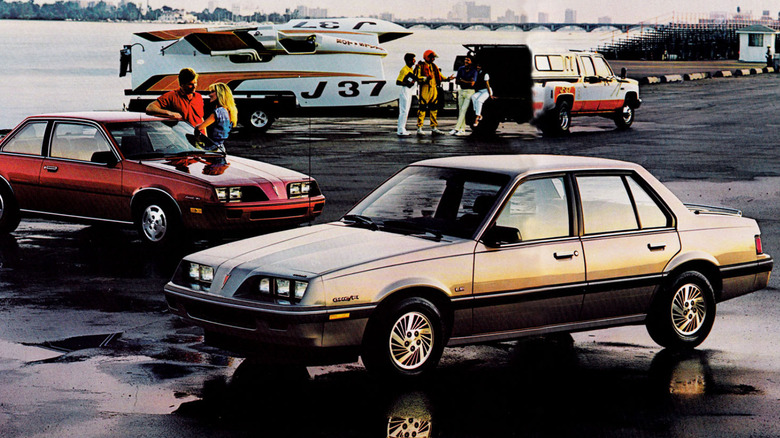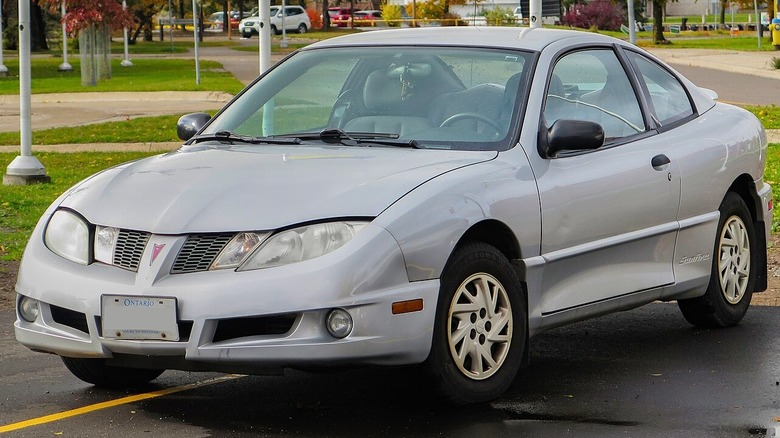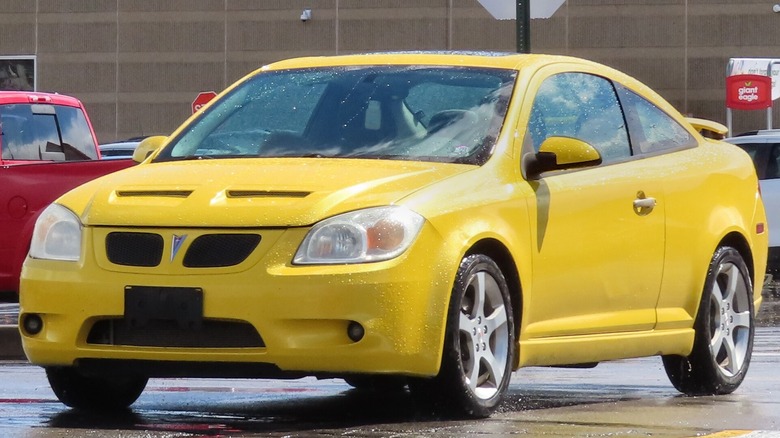Why Was The Pontiac Sunfire Discontinued (And How Long Did It Last?)
Produced for model years 1995-2005, the Pontiac Sunfire easily enters the coveted "Generic 1990s Cars That Are Kind of Cool When You See One That's Still Running" hall of fame. This humble compact, much like an old Dodge Neon or Essex V6-powered SN95 Mustang, found its way into the hands of many budding enthusiasts — generally those who couldn't afford much better.
That said, a Sunfire proved to be a remarkably fun little car, and though seldom seen on the road today, their low price and forgiving handling made them a solid choice for first-time drivers in the 1990s and 2000s. So whatever happened to this car, which met its demise just five years before Pontiac closed its doors? To summarize in a single sentence, in June 2005, GM discontinued all vehicles using the J-platform (including the Sunfire) because that platform dated back to model year 1982, and it was simply time for an update.
In addition, the original plant responsible for Sunfire production faced a long and troubled financial history, further saddling the platform's issues. Coupled with the need for a mid-2000s refresh shared between all of the Big Three automakers — which we'll discuss in further detail — and the Sunfire's days were clearly numbered.
This isn't exactly a top-shelf automobile, and the company went defunct on October 31, 2010, so documentation is generally scant, limited largely to print, internet forums, and similar sources. As such, I'll be relying mostly on anecdotal evidence and contemporary accounts, as well as my own expertise and history in researching obscure vehicles like these, to fill in the blanks. For a complete picture, let's buckle up and start the Sunfire's journey from the very beginning.
A brief history of the J-body Pontiac
The first ever Pontiac utilizing the J-platform debuted for model year 1982, known as the J2000. It shortened the name to just the Pontiac 2000 the following year before finally adopting the name "Sunbird" in 1985 (no, not "Firebird"). This car actually bears a remarkable resemblance to the Sunfire in terms of design philosophy — namely, it's a compact, front-wheel drive platform featuring multiple budget-friendly body styles and a sportier image. As such, while the Sunfire itself didn't launch until 1995, it's more accurately categorized as an evolution of the original Sunbird.
It was during this year that General Motors restructured its Lordstown, Ohio plant, prioritizing the production of small, easily-produced vehicles like the Sunfire and its sister car, the Chevrolet Cavalier. At a cost of an estimated $1 billion, the plant saw extensive remodeling for an all-new facelifted J-body — to the tune of a planned 550,000-vehicle yearly production quota.
This development proved long and costly for GM, representing one of a number of sweeping restructures of the entire company under the leadership of John F. "Jack" Smith. His gamble ultimately paid off in spades, however, with Smith credited as saving General Motors from almost-certain bankruptcy and witnessing $6.1 billion of profit in 1995 alone.
This massive shift in business priorities primed vehicles like the Cavalier and Sunfire to steal the spotlight as GM's bread-and-butter. And GM were in absolutely no financial position to create a new platform in the early-1990s. So rather than reinvent the wheel, it proved far more financially viable for the company to simply update an existing design to meet modern expectations, hence the Sunbird developing into the Sunfire.
The Sunfire's many faces
Pontiac underwent many revisions during the late-1990s to early-2000s, producing many excellent models such as the Firebird, Grand Prix GTX, and Vibe, alongside loathed vehicles like the Aztek. In general, the company typically leaned towards the safer side, badge-engineering most of their models and sharing several common components with other GM vehicles, including J-bodies.
In fact, GM produced exactly 16 nameplates under the J-platform, with the best-selling and longest-running being the Cavalier. However, the Sunfire still sold well for Pontiac, enough for the company to carry its name through no less than two major facelifts and three body types: coupe, convertible, and sedan. Each of these models featured various trim levels, with the top-end being a more tuner-oriented GT.
As for the major updates, the easiest way to tell them apart is the grille shape — the first model, from 1995-1999, featured no front grille above the bumper. The second adopted the two nostrils seen in contemporary Pontiac models, lasting from 2000-2002. The third variant closed out the Sunfire's production run, marked by the headlights running flush with a much wider grille, resembling a bird-like shape common to many late-model Pontiacs. Each model featured a choice of 2-liter four-cylinders, including a base 2.2L, optional 2.3L Quad-4 in 1995 models, and an optional 150-horsepower 2.4L DOHC for the GT (which actually proved to be quite a peppy little engine).
The relatively underpowered, but still fun little engine, front-wheel-drive configuration, and cheap price tag appealed to the entry-level audience looking for something sporty without turning off cautious parents or insurance companies. Overall, a Sunfire wasn't actually that bad for the market it competed in, and it debuted with excellent timing right in the middle of an economic high-point. So what went wrong?
A slow but steady decline
Because the Sunfire was the result of what basically was an emergency measure to get something out the door during massive corporate restructuring, this effectively placed it on borrowed time from Day One, despite its relative success. That doesn't mean it was a bad car; in fact, many contemporary and post-launch reviews praised the Sunfire for its styling and responsive handling characteristics. Plus, it's one of the last of an era where the vast majority of a car's systems were analogue, featuring a pushrod engine, cable-operated throttle, 5-speed manual, wind-up windows, and so on.
Although many enthusiasts find these factors to be nostalgically endearing today, back then, it was rapidly showing its age. Plus, the economic environment was vastly different between the mid-1990s when the Sunfire was introduced and the post-9/11 economic downturn. Coupled with soaring fuel costs, major changes swept through all of the Big Three in an effort to adapt to the changing times.
GM's new compact debuted right at the start of this new economic era, codenamed the "Delta platform," with the introduction of the 2003 Saturn Ion. This meant GM now had a car which superficially resembled the Sunfire in both form and function, but with vastly more modern underpinnings. The Delta platform specifically targeted the economical import market, finding success in this role with the 2004 Chevrolet Cobalt, effectively rendering the J-body obsolete. Subsequently, the last Lordstown-built Sunfire left the factory in May 2004, and the final foreign-built Sunfire was assembled in June 2005, closing out the J-body line for good.
The Sunfire's eventual replacement
As mentioned before, the Big Three all reinvented their brand-images with new or refreshed models during the mid-2000s in an attempt to stave off the crippling financial debt saddling the automotive industry — an effort that proved to be in vain for GM. By 2009, production quotas dropped by 30% in one fiscal year, and the company filed Chapter 11 bankruptcy, subsequently axing both Pontiac and Saturn.
In particular, Pontiac's reputation didn't inspire confidence in GM, having recently released a number of vehicles considered commercial failures. Post-1980s Pontiac was treading water at best, producing many hated models over two decades and culminating in the 2000s with cars like the Aztek. Meanwhile, cars like the Grand Am and G6 were similarly criticized for lack of build quality, poor styling, and being boring to drive. There were many gems from this era, with iconic sports cars like the Solstice, Vibe, and G8. But, sadly, even these wonderful machines weren't enough to offset GM's financial woes.
As such, the Sunfire wasn't even replaced until 2007 by the Pontiac G5. Which, predictably enough, was nothing more than a Cobalt — another of Pontiac's famous badge-engineering jobs. Although, much like the Cobalt itself, the G5 was pretty good. In fact the G5 was probably one of the more exciting cars in the 2007 lineup, and that's saying something considering late-2000s Pontiacs were outstanding. They just were not outstanding enough to save the brand.
General Motors ultimately sealed Pontiac's fate in 2008 with the government bailout, though Pontiac remained solvent until 2010. While the Sunfire's journey effectively ended back in 2005, its general image remained in the 2-door Cobalt until 2010 before the phasing-out of the Delta platform. This finally erased the final traces of the compact FWD Pontiac, and the Sunfire along with it.




